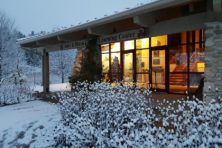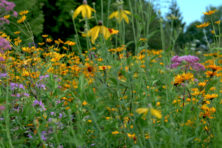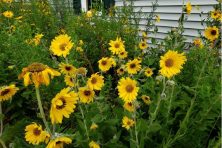Baneberry Plants
- Share
- Tweet
- Pin
- Share

The White Baneberry is the more common one and is producing the “doll’s eye” fruits now. Photo by Roy Lukes.
Hundreds of people hiking in the woods with me during late summer and early autumn have looked at a fruiting and asked, “What kind of a berry is that?” Frequently it turned out that the fruit was not a berry but rather a pome, drupe or drupelet.
In the technical botanical sense, a berry is a fleshy or pulpy fruit that does not usually open, has few or many seeds, but no stone. It always develops from a single enlarged ovary. Examples of berries are cranberry, currant, blueberry, huckleberry, baneberry, grape, tomato and eggplant.
Examples of pomes would be an apple, pear, hawthorn and serviceberry, often called Juneberry or shadberry. A drupe is a fruit that does not split. The seed is enclosed in a bony stone; hence such fruits are often called stone fruits. Peaches, plums, cherries and olives are drupes.
Raspberries and blackberries are really collections of tiny drupelets attached to a small receptacle. However, could you imagine calling them raspdrupelets and blackdrupelets? I can’t either!
One of the most interesting photographs I have is a close-up of a Thimbleberry flower showing the circle of several dozen stigmas just inside the large showy white petals, serving as “advertising banners” to potential pollinators. One can easily sense that each stigma, when pollinated, will lead to the development of one seed.
When you pick a tangy Thimbleberry (ripe now) or raspberry, the mass of drupelets parts from the receptacle and the fruit is hollow. The mass of drupelets on a blackberry adheres to the small fleshy receptacle which is a part of the berry and is eaten.
One of the most striking and eye-catching of the true berries, now at the peak of their beauty, found growing in the cool shady woods is the White Baneberry. These hardy native perennials with the showy spikes of white berries are said to be mildly poisonous, hence the name baneberry. Personally speaking I find it difficult to imagine something being mildly poisonous. In my estimation it is either poisonous or non-poisonous. I have told many hundreds of people hiking with me in the September woods that the White Baneberries are very poisonous. In fact I’ve found it a good time to introduce them to the word “bane” meaning that which destroys life.
Many people call this attractive plant doll’s eyes. The fruit is a four or five-inch long cluster of loosely spaced oval white berries, each with a dark purple to black spot on the end, the bold spot formed where the broad stigma of the tiny flower was attached.
The story is that the berries resembled the old-fashioned china eyes that small children so frequently managed to gouge from their dolls’ heads, hence the name of doll’s eyes.
The ivory-toned berries are supported on much thickened pinkish-red pedicels and peduncles. The pedicel is the short stalk to which the berry is fastened, while the peduncle is the central stalk from which emanate the individual pedicels. Because the plant may grow as tall as three feet, it strikes a very imposing picture against the mostly earthy greens and browns of the fall woods.
Linnaeus named the plant Actaea (ak-TEE-a), the ancient name of the Elder. Its species name, pachypoda (pa-KIP-o-da) means thick-footed in allusion to the thick, brilliant red stalks.
Muenscher, in his excellent book Poisonous Plants of the United States, published by MacMillan, tells about someone’s experience of consuming six of the White Baneberries which in turn produced increased pulse, dizziness, burning in the stomach, and colicky pains. The following is from “Rhodora,” 5:77 (1903): “The pulse rose to 125, was irregular, wiry, tense, the heart fluttered most unpleasantly.” The rootstalk is a violent purgative, irritant and emetic.
It is quite logical that most poisoning occurs with children, perhaps those still in the so-called grazing stage. Experts with food and wild berry poisoning claim that the berries are so utterly bitter-tasting that one tiny bite is usually enough to cause a person to immediately spit it out.
It was interesting to learn that, for example, deer, squirrels, chipmunks, voles and quite a few species of birds are tolerant to the poison and are known to safely consume the berries.

This red form of the Baneberry plant is quite showy. Photo by Roy Lukes.
Because the berry juice is toxic and has a sedative effect, it was occasionally used by the early Native Americans in concentrated form to poison projectile tips, including spear and arrowheads.
Occasionally one comes across the Red Baneberry, Actaea rubra, which has a more globular cluster of very shiny red berries, as though varnished, and supported on thin green stems or pedicels. Frequently the white variety (referred to as neglecta) is more abundant than the red. These berries have smaller black “dots” and also the thin pedicels of the red species.
One of the few wild animals reputed to safely eat the berries of the doll’s eyes is the Ruffed Grouse. I trust that the grouse, during its wanderings, will inadvertently scatter the seeds of the doll’s eyes (via the bird’s droppings), which will grow and emblazon the forest with their handsome red and white “ornaments.”



